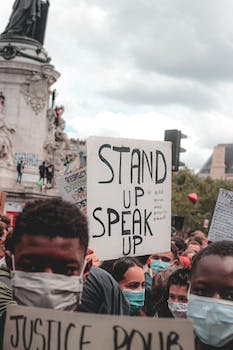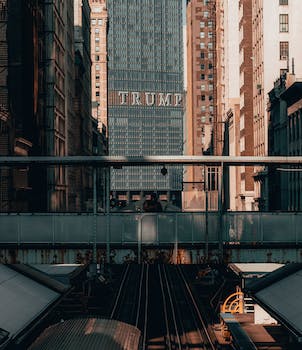

-
Table of Contents
Uncovering the Truth: The 6th January Capitol Riot and the Fight for Democracy
Introduction
Introduction:
The events of the 6th January Capitol Riot shook the United States and reverberated around the world. This unprecedented attack on the heart of American democracy highlighted the fragility of democratic institutions and the importance of safeguarding them. In this article, we will delve into the details of the Capitol Riot, examining the motivations behind it, the consequences it has had on American society, and the ongoing fight for democracy in its aftermath. By uncovering the truth behind this pivotal event, we aim to shed light on the challenges faced by democratic nations and the urgent need to protect and strengthen democratic values.
The Role of Social Media in the Capitol Riot: Unveiling the Truth
The events that unfolded on the 6th of January, 2021, at the United States Capitol were unprecedented and shocking. The world watched in disbelief as a mob stormed the symbol of American democracy, leaving destruction and chaos in their wake. As the dust settled, questions arose about how such an event could occur in a country known for its democratic values. One aspect that quickly came under scrutiny was the role of social media in fueling the Capitol riot.
Social media platforms have become powerful tools for communication and information sharing. They have the ability to connect people from all corners of the globe, allowing for the rapid dissemination of ideas and opinions. However, this immense power can also be harnessed for nefarious purposes. In the case of the Capitol riot, social media played a significant role in organizing and inciting the violence.
Platforms such as Facebook, Twitter, and Parler were used by individuals and groups to plan and coordinate their actions on the day of the riot. Messages and posts calling for violence and insurrection were shared widely, creating an echo chamber of radicalized individuals. The speed and reach of social media allowed for the rapid mobilization of a large number of people, who believed they were fighting for a cause they deemed just.
The spread of misinformation and conspiracy theories also played a crucial role in the events leading up to the Capitol riot. False claims of election fraud and a stolen election were amplified on social media, leading many to believe that their democratic rights were being trampled upon. These falsehoods were not only shared by individuals but also by influential figures, including some politicians and media personalities. The combination of misinformation and a sense of injustice fueled the anger and frustration that ultimately erupted on that fateful day.
The role of social media in the Capitol riot raises important questions about the responsibility of these platforms. While they have taken steps to combat the spread of misinformation and hate speech, critics argue that more needs to be done. The algorithms that power social media platforms are designed to maximize engagement, often leading to the amplification of extreme views. This creates an environment where misinformation and conspiracy theories can thrive, further polarizing society.
In the aftermath of the Capitol riot, social media companies faced intense scrutiny and pressure to take action. Twitter permanently suspended then-President Donald Trump's account, citing the risk of further incitement of violence. Facebook and other platforms also suspended Trump's accounts, albeit temporarily. These actions sparked a debate about the power of social media companies to regulate speech and the need for greater transparency and accountability.
Efforts to regulate social media platforms have gained momentum in the wake of the Capitol riot. Lawmakers have called for increased oversight and regulation to prevent the spread of harmful content and to protect democratic institutions. However, finding the right balance between freedom of speech and the need to combat misinformation and incitement to violence is a complex task.
The events of the 6th of January, 2021, serve as a stark reminder of the power and influence of social media. While these platforms have the potential to connect people and foster positive change, they can also be manipulated to sow discord and incite violence. The fight for democracy requires a careful examination of the role social media plays in our society and the steps needed to ensure that it is used responsibly and ethically. Only then can we hope to prevent future events like the Capitol riot and safeguard the principles upon which our democracies are built.
Investigating the Motives Behind the Capitol Riot: Uncovering the Truth

The events that unfolded on the 6th of January, 2021, at the United States Capitol were unprecedented and shook the very foundations of American democracy. As the world watched in disbelief, a mob of supporters of then-President Donald Trump stormed the Capitol building, resulting in chaos, violence, and the tragic loss of lives. In the aftermath of this shocking event, investigators and experts have been tirelessly working to uncover the truth behind the motives that led to this riot.
To understand the motives behind the Capitol riot, it is crucial to examine the political climate leading up to that fateful day. The 2020 presidential election had been highly contentious, with Trump and his supporters repeatedly making baseless claims of widespread voter fraud. These claims were thoroughly debunked by election officials, courts, and even Trump's own Department of Justice. However, they fueled a sense of anger and mistrust among his most ardent followers.
On the day of the riot, Trump addressed a large crowd of his supporters, reiterating his false claims of a stolen election and urging them to "fight like hell" to overturn the results. This fiery rhetoric, combined with the deep-seated belief in the illegitimacy of the election, served as a catalyst for the events that followed. Many of those who stormed the Capitol genuinely believed they were defending democracy and saving the country from an alleged coup.
However, it is important to note that not all participants in the riot were driven by a sincere belief in their cause. Extremist groups, such as white supremacists and far-right militias, also played a significant role in orchestrating and escalating the violence. These groups saw the chaos as an opportunity to further their own agendas and sow division within the country. Their presence and actions cannot be overlooked when investigating the motives behind the Capitol riot.
The investigation into the Capitol riot has also shed light on the role of social media in fueling and organizing the events. Platforms like Facebook, Twitter, and Parler became breeding grounds for conspiracy theories, hate speech, and plans for the attack. The ease with which misinformation spreads on these platforms, coupled with the algorithms that prioritize engagement over accuracy, created an echo chamber that amplified extremist views and facilitated the coordination of the riot.
As investigators delve deeper into the motives behind the Capitol riot, they are faced with the complex task of distinguishing between those who genuinely believed they were defending democracy and those who sought to exploit the situation for their own gain. The truth is likely a combination of both, with a range of motivations driving different individuals to participate in the violence.
Ultimately, the Capitol riot was a stark reminder of the fragility of democracy and the dangers of unchecked misinformation and extremism. It highlighted the urgent need for a comprehensive examination of the factors that led to this event and the implementation of measures to prevent such incidents from happening again. Only by uncovering the truth behind the motives can we hope to heal the deep divisions that have plagued our society and safeguard the principles upon which our democracy stands.
The Aftermath of the Capitol Riot: Unmasking the Truth
The events that unfolded on the 6th of January, 2021, at the United States Capitol were nothing short of shocking. As the world watched in disbelief, a mob of supporters of then-President Donald Trump stormed the Capitol building, leaving a trail of destruction and chaos in their wake. The aftermath of this unprecedented attack on American democracy has been a long and arduous journey towards uncovering the truth.
In the immediate aftermath of the riot, the nation was left grappling with the enormity of what had just occurred. The images of rioters scaling the walls of the Capitol, vandalizing offices, and clashing with law enforcement officers were seared into the collective memory of the American people. Questions swirled about how such a breach of security could have happened and who was responsible for inciting the violence.
Law enforcement agencies swiftly launched investigations into the events of that fateful day. The FBI, in particular, played a crucial role in identifying and apprehending those involved in the riot. Through the use of surveillance footage, social media posts, and tips from the public, authorities were able to piece together a clearer picture of the individuals responsible for the attack. The subsequent arrests and prosecutions have shed light on the motivations and ideologies that fueled the rioters.
One of the key aspects of the investigation has been the identification of extremist groups and individuals involved in the Capitol riot. The presence of far-right groups, such as the Proud Boys and QAnon adherents, among the rioters has raised concerns about the rise of domestic terrorism in the United States. The investigation has also revealed the alarming extent of online radicalization and the role that social media platforms played in organizing and inciting the violence.
As the legal proceedings against the rioters continue, the fight for democracy has taken on a new urgency. The events of January 6th served as a wake-up call for many Americans, highlighting the fragility of democratic institutions and the need for vigilance in protecting them. The riot exposed deep divisions within the country, with some segments of the population embracing conspiracy theories and disinformation that undermine the very foundations of democracy.
In response to the Capitol riot, lawmakers have introduced legislation aimed at strengthening the nation's defenses against future attacks on democracy. The proposed bills seek to address issues such as domestic terrorism, online radicalization, and the security of government buildings. The hope is that these measures will not only prevent similar incidents from occurring but also restore faith in the democratic process.
The aftermath of the Capitol riot has also sparked a broader conversation about the state of democracy in the United States. Many have argued that the events of January 6th were not an isolated incident but rather a symptom of deeper systemic issues. The riot laid bare the stark realities of racial inequality, political polarization, and the erosion of trust in institutions that have plagued the nation for years.
In conclusion, the aftermath of the Capitol riot has been a tumultuous period of reckoning for the United States. The investigations and legal proceedings have begun to uncover the truth behind the attack, shedding light on the individuals and groups responsible. However, the fight for democracy is far from over. It requires a collective effort to address the underlying issues that allowed such an event to occur and to rebuild trust in democratic institutions. Only through this ongoing struggle can the nation hope to heal and move forward towards a more inclusive and resilient democracy.
Q&A
1. What was the significance of the 6th January Capitol Riot?
The 6th January Capitol Riot was significant as it involved a violent attack on the United States Capitol by supporters of then-President Donald Trump, aiming to overturn the 2020 presidential election results.
2. What were the main objectives of the rioters during the Capitol Riot?
The main objectives of the rioters during the Capitol Riot were to disrupt the certification of the Electoral College results, prevent the peaceful transfer of power, and challenge the legitimacy of the election.
3. How did the Capitol Riot impact the fight for democracy in the United States?
The Capitol Riot had a significant impact on the fight for democracy in the United States as it highlighted the fragility of democratic institutions and the potential for violence when political divisions escalate. It also led to increased scrutiny of election processes and security measures to safeguard democracy.
Conclusion
In conclusion, the events of the 6th January Capitol Riot serve as a stark reminder of the ongoing fight for democracy. The attack on the United States Capitol was a direct assault on the principles of democratic governance and the peaceful transfer of power. It highlighted the deep divisions within society and the urgent need for truth, accountability, and a commitment to upholding democratic values. Uncovering the truth behind this riot is crucial for ensuring justice, safeguarding democracy, and preventing such incidents from happening again in the future.












